An Enterprise Server Workspace provides an advanced, manufacturing-orientated CAD-centric view of a project when opened in the browser interface. This interface offers Design, Tasks, Releases, Activities, and History view options, available in the left-hand navigation pane:
- Design – display and navigate source project design documents, view design object properties and place review comments. This view uses the Web Viewer interface to present your design across four distinct data sub-views, to show the source schematic(s), board in 2D and 3D, Draftsman documents, and the Bill of Materials (BOM) respectively. The Design view is for the latest version of the source project data, rather than a specified release from that project, and so could be considered to be a work-in-progress (WIP) view. You can review both the base design and that of any defined Variant.
- Simulation – upload simulation results files to the current project, which are then available for inspection or downloading by all users who have access to the project.
- Tasks – view and manage assigned Task activity requests that apply to the current project. Tasks that relate to a project document are created by assignment through the Comments system (in either Altium Designer or the Workspace). Tasks that apply to this project, but not to a specific document or comment, can be created on this page as General Tasks.
- Releases – view the releases for the project. Access is provided for opening a specific Release for detailed inspection in a Manufacturing Portal page. From this portal you can view and navigate the released file data, inspect the BOM, and view and comment on the snapshot of the design itself; the source for that released data. You also have the ability to perform design data comparisons between releases.
- Activities – create or view active/closed Process workflow Activities that apply to the current project. The listed processes provide an overview of the state of each process, including its instigator and who it is assigned to, when it was invoked, and the current stage of its Workflow. Select a Process entry to view additional detail that includes its notated Workflow diagram, a summary of its associated process data, and the sequential history of its Workflow events.
- History – browse a progressive timeline of major events relating to the project, including its creation, commits, releases, and clones. Each time a supported event happens in association with the project, that event is added to the timeline as a dedicated tile with various actions supported where applicable. You also have the ability to perform design data comparisons between release events.
- Assembly Assistant – provides access to a visual board assembly tool based on an interaction between BOM entries and their graphical counterparts. An audited step-through process can be invoked that helps you move through the steps of physically assembling a PCB board, where each process step can be marked as
Done or Skipped (to be completed later). This provides a tracked assembly progress view in a single location, which avoids complex manual or paper-based board assembly checking processes.
A project is opened from the Workspace's Projects page by double-clicking on the project entry, by a single click on its title, or by selecting the project and choosing the Open option from the  menu or project
menu or project  menu. The page will open in a new browser tab.
menu. The page will open in a new browser tab.
 Accessing the CAD-centric Projects Management page for a project.
Accessing the CAD-centric Projects Management page for a project.
The Workspace Web Viewer also supports a unique structural and design view of Multi-board projects. Open the below collapsible section for more information.
Viewing Multi-board Projects
Copy Link
Copied
Multi-board projects support the high-level interconnection of multiple PCB projects to provide system-level design in Altium Designer – see Designing with Multiple PCBs for more information.
The Workspace Web Viewer provides an extended interface for Multi-board projects which includes the Multi-board PCB project structure (Projects view) and the high-level Schematic and Assembly documents that encompass that structure (Design view):
-
Child Projects view – includes individual project designs that are incorporated within the Multi-board project (its sub-modules). Each of the included sub-projects can be opened individually as normal.
 Open a Multi-board project to view and access its constituent projects in the Projects view. Full support of Multi-board projects is provided in Altium Designer.
Open a Multi-board project to view and access its constituent projects in the Projects view. Full support of Multi-board projects is provided in Altium Designer.
- Design view – provides access to the Multi-board project's main schematic-based connectivity document (MBS), the project's physical assembly document (MBA) which is rendered from its constituent PCB modules and 3D design files (typically
*.STEP or *.stp), and collated BOM.
See Multi-board Design View for more information on working with the Web Viewer Design view.
- The Tasks view includes user-created Tasks that apply to each of the Multi-board project's constituent (child) PCB projects.
- The Releases view includes a composite listing of Releases that apply to each of the Multi-board project's child PCB projects. See example.
- The History view includes Commit events that apply to the Multi-board project itself.
- Multi-board projects may be shared with other Workspace members – see related information.
A project also can be opened in the Workspace's browser interface from within Altium Designer. For the active Workspace project, use the Project » Show in Web Browser command from the main menus. Alternatively, right-click on the entry for the project in the Projects panel and choose the Show in Web Browser command from the context menu.
When browsing the project through the Altium Designer Explorer panel – configured in its default Project View rather than Classic View – use the  button to open the project in the Workspace's browser interface.
button to open the project in the Workspace's browser interface.
The following sections take a closer look at the seven views into the project design and its data, as presented in the page for an opened project.
Design
Copy Link
Copied
Related page: Web Viewer
The Design view provides interactive visual access to the project's design documents, property data for objects within those documents, and the ability to collaboratively comment on definable document locations. This view is for the latest version of the source project data, rather than a specified release from that project, and so could be considered to be a work-in-progress (WIP) view. You can review both the base design and any available variant of that design.
The Design view also allows you to search, select, cross-probe, and inspect components and nets throughout the design and across the various sub-views as applicable. And when viewing the board in 2D, you can even take measurements.

The Design view utilizes Altium's Web Viewer functionality to provide detailed review access to the project's source schematic and PCB documents. Shown here is a schematic – hover over the image to see the PCB.
Based on an advanced graphics engine and interface – Altium's Web Viewer – you are provided with all the features needed to locate and visually inspect the design and its objects. The view also includes fully rendered 2D and 3D PCB layout views, object search and select capabilities, and tree-based design document navigation. Its additional information pane provides an interface to the active Comments system – which dynamically interacts with the design space – and a comprehensive properties listing for any selected design object.
Support is provided for downloading a Zip archive containing a snapshot of the WIP design project (base design), as well as the ability to generate and download a range of derived outputs, which take setup information directly from the applicable Output Job file (where one exists). These include Gerber and NC Drill files, Schematic and Assembly PDFs, and CSV-formatted BOM data.
See the
Web Viewer page for more information on the Design view functions.
Simulation
Copy Link
Copied
The Simulation page represents a storage location for circuit simulation results files that will be associated with the current project or project release. Imported simulation files are effectively attached to the project, which allows members of the Workspace to inspect and/or download simulation results documents that relate to the currently open project.
Generic simulation files can be uploaded to the Workspace Simulation - Uploads sub-location (effectively Folder) of the Simulation page. The folder supports an open range of data file formats such as PDF, XLS, HTML, archives (Zip, 7z, etc), and so on. Upload your first simulation results file by dropping a local file onto the page, or by browsing to and selecting a local file through the choose from your computer option. Use the  button at the top of the page for subsequent uploads.
button at the top of the page for subsequent uploads.
 Upload Simulation results to a project in a range of file formats, for access by Workspace members.
Upload Simulation results to a project in a range of file formats, for access by Workspace members.
The uploaded file is associated with the most recent project commit – the project's current revision – as detailed in the file entry's Related to column. Click on the accompanying  icon to open the associated project Commit.
icon to open the associated project Commit.

Files also can be uploaded to a specific Project Release through the Workspace Releases page, in this case by using the Attach Simulations option from a Release entry's  menu to select and upload a local file. The added simulation file is then listed as included in the Release, and its presence indicated by the release's additional
menu to select and upload a local file. The added simulation file is then listed as included in the Release, and its presence indicated by the release's additional  icon.
icon.
 Upload Simulation results files directly to a specific project Release.
Upload Simulation results files directly to a specific project Release.
An opened project Release also includes the Simulation file listing as it relates to that specific release. As with the main project Simulation list, this allows you to upload and manage attached Simulation results files, but for this particular project Release.
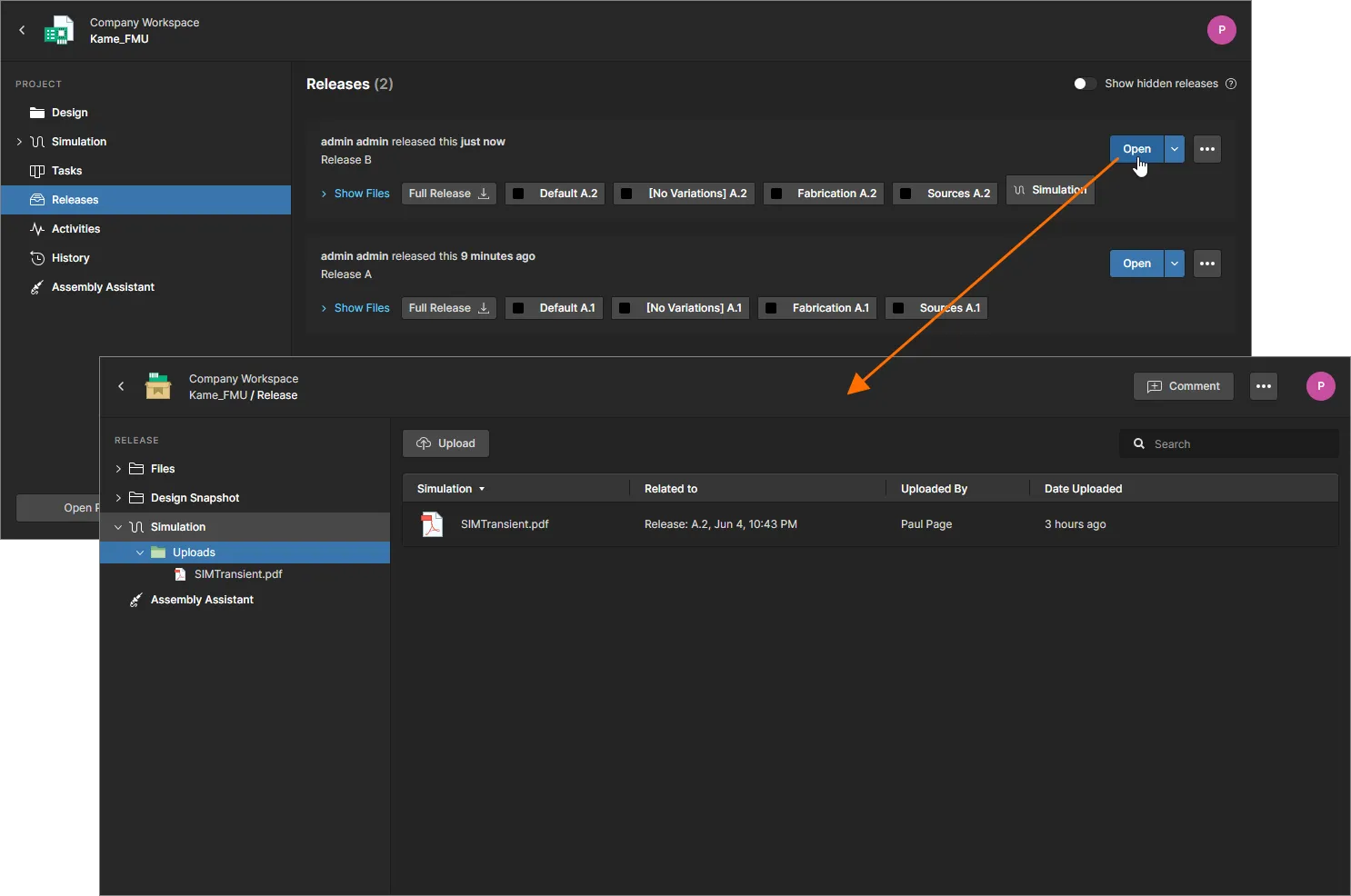
Back on the main Simulation page, all uploaded files that have been added to the current project – including those uploaded to a project Release – are included in the Uploads list.
 File uploads associated with both Commits and Releases are included on the Simulations page, where file management options are also available.
File uploads associated with both Commits and Releases are included on the Simulations page, where file management options are also available.
Use an entry's  drop-down menu to access the following file commands:
drop-down menu to access the following file commands:
- Open – access file for viewing (PDF only) or downloading. PDF example.
- Edit – change the file's name and add a description, which will appear under the entry's filename.
- Download – immediately download the file to your browser's default download location. Note that for other file references a download icon (
 ) is associated with file name.
) is associated with file name.
- Delete – completely remove the selected file (and any associations) from the Workspace.
The Related to cell for each entry in the Simulations page list includes a direct link to its associated Commit or Release ( ).
).
Tasks
Copy Link
Copied
Related information: Working with Workspace Tasks, Web Viewer – Commenting Window.
This view allows you to access and manage the Tasks – job activity requests – that apply to the currently open design project. Tasks are presented in a Kanban board flow style, with their progress state (ToDo, InProgress and Resolved) moving through Task rows. One row is reserved for general Tasks (those not associated with a design document), and each remaining row applies to Tasks for a specific project document. General Tasks are created from within the dashboard and document-specific Tasks are created by assigning a Workspace member to a project Comment.
The view also incorporates Tasks created by Process Workflows, which are indicated by the process Name and its current progress state. Selecting a process workflow tile will open its related task in the workflow, which can be completed by the user it is assigned to.

Manage and work with collaborative job activity Tasks through the Workspace Tasks dashboard.
Although presented through a relatively simple interface, the Workspace Tasks dashboard offers a flexible and efficient way of both managing and tracking work progress within the actual design environment rather than via an external system. This page is a project-specific view of Tasks that are currently active for the open Workspace project, while the global Tasks view available from the main Workspace navigation tree represents Tasks that are active for all projects in the Workspace.
Releases
Copy Link
Copied
The Releases view presents all project release packages that have been generated from the design space (see Design Project Release), where each package incorporates the released Source, Fabrication and Assembly data.
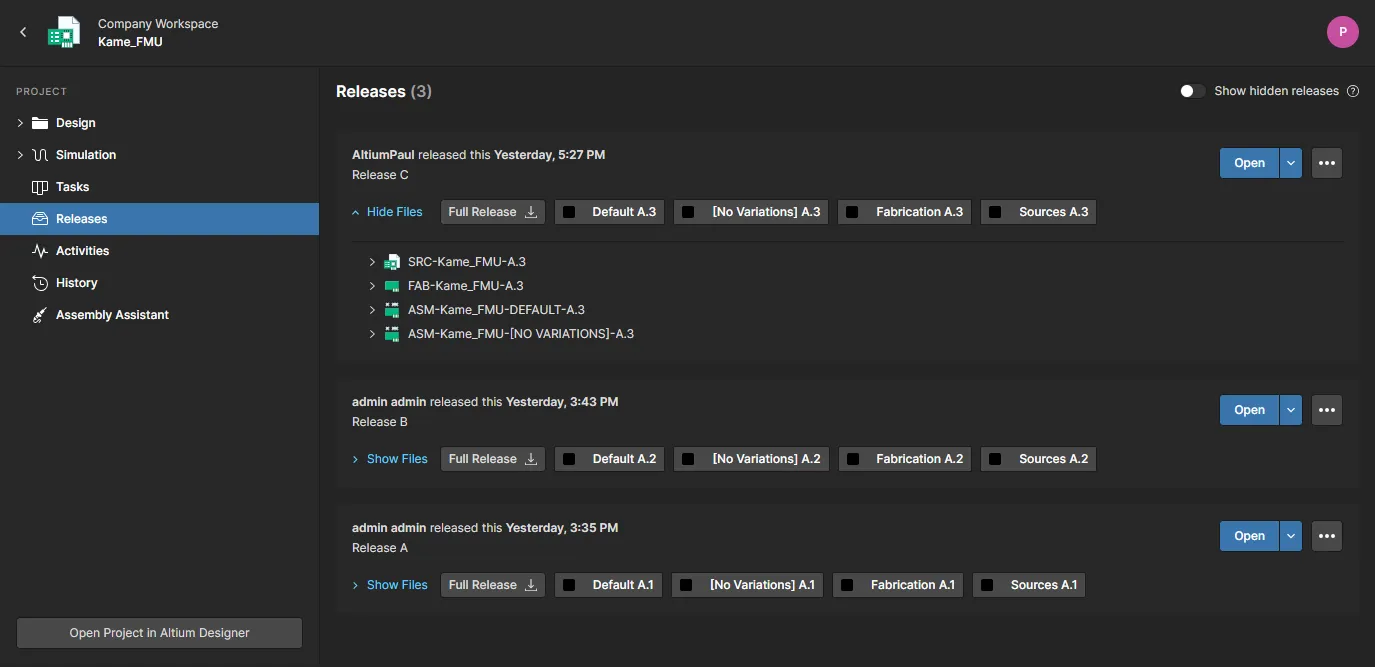
The Releases view gives you access to the released data packages, with the ability to open a package for closer inspection through a dedicated Manufacturing Portal, and also to send a release to your manufacturer as a Manufacturing Package.
From this view, you can:
- Download any and all of the data sets included in a release. Click the
 button associated to the release to access a window in which to define which of that release's data sets to download. After clicking the
button associated to the release to access a window in which to define which of that release's data sets to download. After clicking the  button a single Zip archive containing a folder for each included data set will be downloaded to your browser's default downloads folder.
button a single Zip archive containing a folder for each included data set will be downloaded to your browser's default downloads folder.
- Open a release, which will be presented on a separate tab through a Manufacturing Portal. From this portal, you can view and navigate the released file data, inspect the BOM, and view and comment on the snapshot of the design itself; the source for that released data. You'll also have access to controls for downloading manufacturing data at various levels of granularity (from full data set(s) to individual generated output file(s)).
- Perform comparisons between the Gerber, BOM, Schematic, or PCB data of different releases – see Design Data Comparisons for more information.
- Change the lifecycle state for any of the data sets in a release.
- Attach simulation-related files to a release.
- Toggle the display of releases that contain one or more data sets in an inapplicable revision state (e.g., Deprecated, Obsolete, Abandoned states, and where such a state has its Allowed to be used in designs property disabled) using the Show hidden releases control.
The following sections take a closer look at these various features and functionality in closer detail.
Browsing a Release Package
To open the full release package for viewing, click on its associated  button. Alternatively, click the
button. Alternatively, click the  button and choose what to view – either the full release package (Full Release) or a specific assembly (variant). An opened release package is presented in a new Manufacturing Portal browser tab.
button and choose what to view – either the full release package (Full Release) or a specific assembly (variant). An opened release package is presented in a new Manufacturing Portal browser tab.
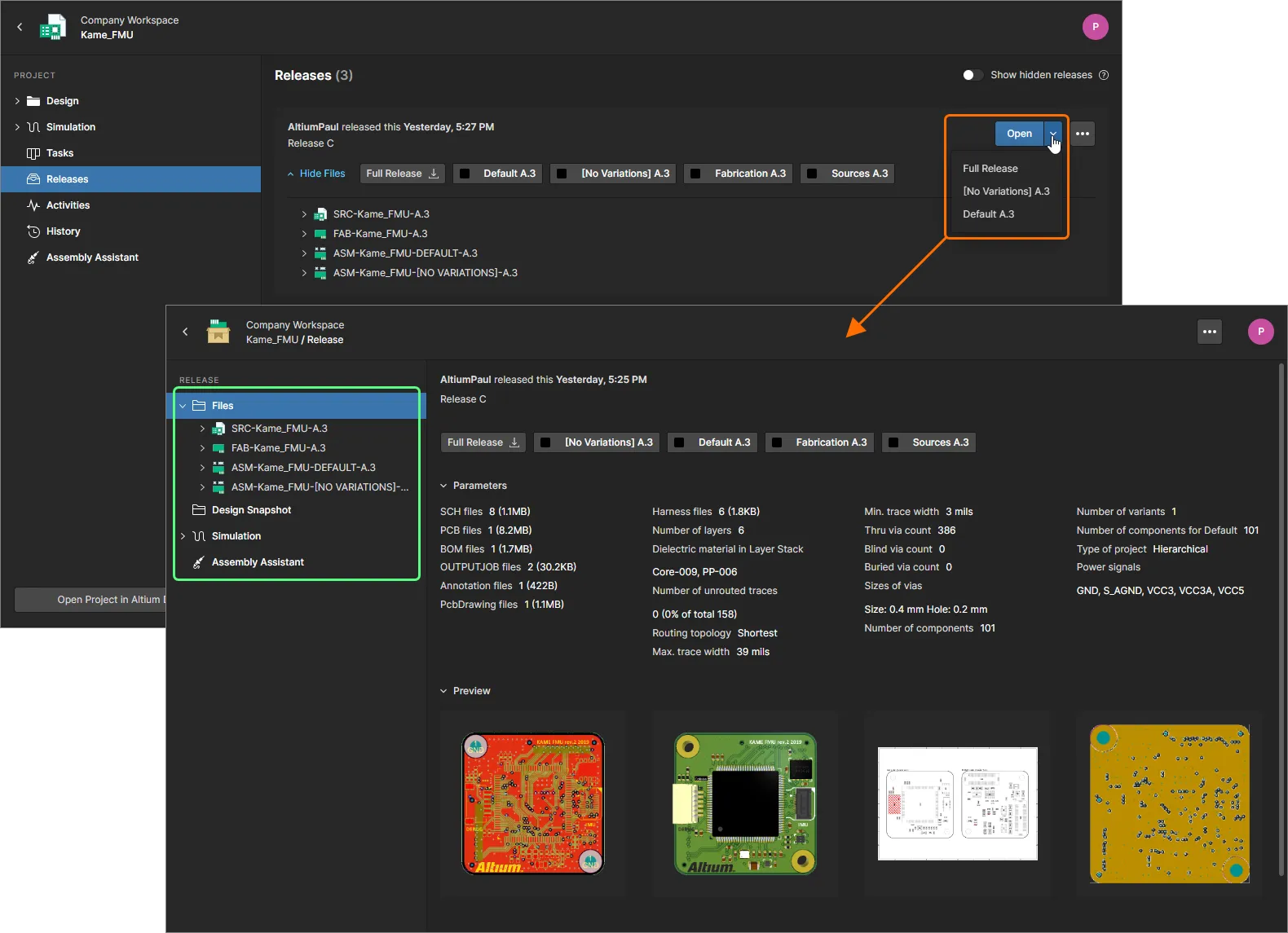
The Manufacture view gives you access to the released data packages, and the ability to open a package for closer inspection through a dedicated Manufacturing Portal.
An opened project release, or a specified variation of it, is presented in a new Manufacturing Portal browser tab and incorporates further sub-views:
Files
Copy Link
Copied
The Files view presents an overview of the release package in terms of what data sets it contains, Workspace-side parameters, and design previews such as the board in 2D and 3D. The full release package can be downloaded from this page in a single Zip archive (click  ).
).
Expand the tree on the left to view the data sets involved in this release and the data each contains. For the design source, this is the snapshot of the design with all source files used in the release of this particular package. For the fabrication and assembly data sets, this will be the output manufacturing data generated as part of the release. Download is supported at all levels of granularity – from the whole data set, to a particular folder/type of output, down to the individual file level. Hover over an entry and click  the button to start the download, or for entries other than Gerber and PDF files, select the entry and click the
the button to start the download, or for entries other than Gerber and PDF files, select the entry and click the  button within the main viewing area. For a data set or specific folder of output, a Zip archive will be downloaded to your browser's default downloads folder. For an individual file, that file (not zipped) will be downloaded.
button within the main viewing area. For a data set or specific folder of output, a Zip archive will be downloaded to your browser's default downloads folder. For an individual file, that file (not zipped) will be downloaded.
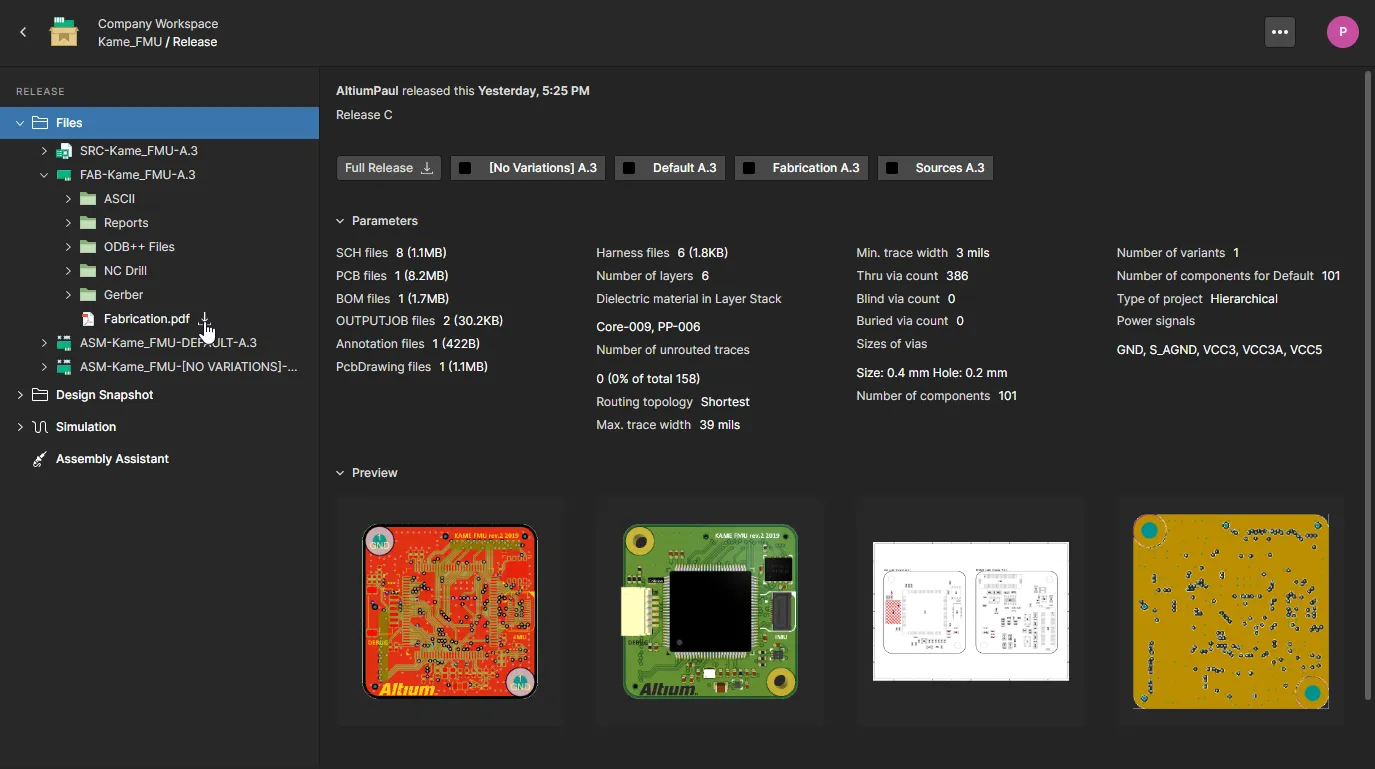
Select any file within the Gerber output list to see a graphical composite of the released Gerber data. Use the Layers menu to view the Gerber data for a specific layer, and the panel options on the upper right to access the Gerber viewer's measurement, commenting and download features. The viewing of PDF files also is supported – scroll or use the Page dropdown menu to navigate through the PDF pages, and the Information panel on the right ( ) to view the PDF's metadata.
) to view the PDF's metadata.
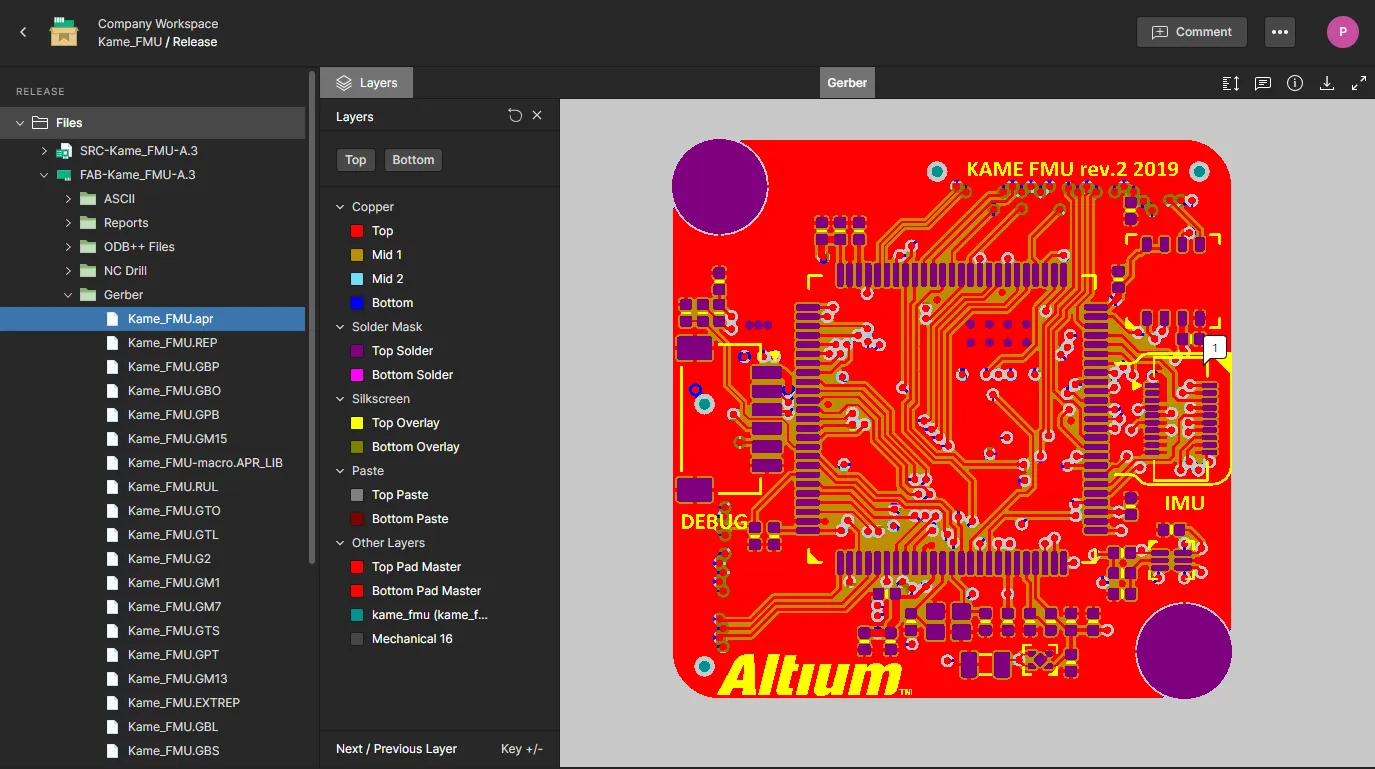
Browsing controls for the above graphical views are:
- Mouse wheel forward/backward to zoom in/out.
- Click & hold (or right-click & hold), then drag to pan document.
Design Snapshot
Copy Link
Copied
The Design Snapshot view applies the Web Viewer interface to provide interactive visual access to the design documents, property data for objects within those documents, and the ability to collaboratively comment on definable document locations. Standard review features include PCB layer visibility selection, comment markup, as well as the ability to search, select, and inspect components and nets. You can take measurements in the 2D PCB view.

See the
Web Viewer page for more information on the
Design Snapshot view functions.
- In either of the above views, click the
 button at the top-right of the view to access controls for changing the lifecycle state of the data sets contained in the release, attach simulation-related files to the release, and also select a Data Comparison feature.
button at the top-right of the view to access controls for changing the lifecycle state of the data sets contained in the release, attach simulation-related files to the release, and also select a Data Comparison feature.
- The Simulation and Assembly Assistant views provide additional features for project collaborators. Any imported Simulation results files will be specific to the release, and similarly, the BOM and assembly data harnessed by the Assembly Assistant will relate to the specific release.
Activities
Copy Link
Copied
The Activities view provides a detailed overview of the Processes associated with the project, and the current state of their progress – represented as a user-highlighted task step in their workflow diagrams. Use the Open/Closed menu options in the page header to list current or completed project activities, the upper Search field to filter the listing by an expression contained in any column field (except dates), and the  button to invoke a new process activity from a list of enabled processes.
button to invoke a new process activity from a list of enabled processes.
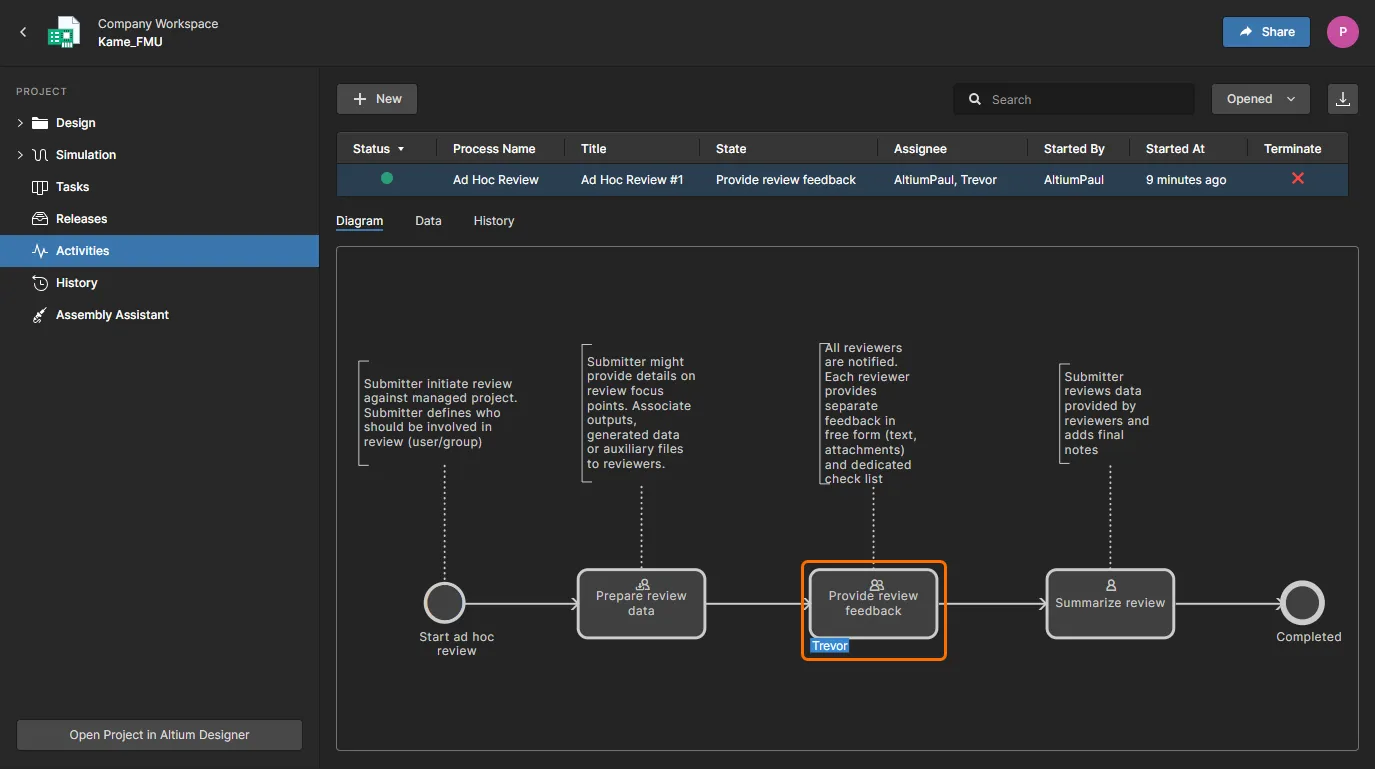
Along with an annotated graphic representing the flow and state of an activity (Diagram mode), the view also includes a Data view mode that lists parametric data relating to the activity (associated users, project information, etc.), and a History mode showing the sequence of workflow events (start, preparation, task completion, etc.).
Project activities are typically invoked in Altium Designer by selecting an available process from the Project » Activities menu. The activity is then assigned to an available project and data, a user for review, and if required, a nominated user as a review coordinator. Tasks are automatically created for those users, and will appear in their Altium Designer Tasklist panel, in the Workspace Tasks view for this project, and in the Workspace's main (global) Tasks page.
Project activities, such as Ad-hoc, Milestone and Handoff Reviews, are enabled and configured by a Workspace administrator on the
Processes Management page (
Admin – Processes). In the above
Activities view, administrators also may cancel (
Terminate) an active process, or download a CSV file that includes the information on all listed activities (

).
History
Copy Link
Copied
Related page: Project History
The History view provides a progressive timeline of major events relating to the project – its creation, commits, releases, clones and MCAD exchanges – with various actions supported where applicable, including Design Data Comparisons between history events.
 The History view presents a timeline of basic events that have occurred during the project's evolution.
The History view presents a timeline of basic events that have occurred during the project's evolution.
The view can essentially be broken down into three key sections:
- Main trunk of the timeline. Direction of event chronology is from the bottom up. The first event – the creation of the project – will appear at the bottom of the timeline, with subsequent events appearing above and the latest (the most current event) appearing at the top.
- Events. Each time a supported event happens in association with the project, that event is added to the timeline as a dedicated tile. Each type of event will have a different colored tile and will either be linked directly to the main trunk of the timeline, or have some additional icon next to it (as is the case for MCAD Exchange events). For Commit events design diffing is supported, showing basic information on what has changed between the current and previous commits (including files, components, nets, PCB structure, variants) – use the
 button to expand the tile view.
button to expand the tile view.
For the following two event types, additional operations are accessible from the event tile:
- Commit event – ability to create a clone of the project using that version of the design, the ability to view or download the source files of that version of the design (a Commit snapshot), and the ability to compare the Commit to the design data of another Commit and/or Release.
- Release event – the ability to open that release package for viewing through a manufacturing portal and the ability to download either the full release package or the source files of the version of the design that was used to create that release package. You can also access the Schematic comparison, PCB Comparison, Gerber comparison, and BOM Comparison features.
- Search. Click the
 control at the top-right of the view to access a search field that facilitates basic searching of the project history. As you type your search string, filtering will be applied to the timeline to present only the events relevant to that search.
control at the top-right of the view to access a search field that facilitates basic searching of the project history. As you type your search string, filtering will be applied to the timeline to present only the events relevant to that search.
Whenever a supported event happens in relation to the project, that event will be detected and made available to the History view automatically. Notification will appear at the bottom of the view shortly after the event takes place – click the  control to update the timeline with the new event. A manual refresh is also provided, performed by clicking the
control to update the timeline with the new event. A manual refresh is also provided, performed by clicking the  control at the top-right of the view.
control at the top-right of the view.
Assembly Assistant
Copy Link
Copied
Related page: Assembly Assistant
This view provides access to a board assembly process helper application that brings together the project's detailed BOM data and its 2D/3D assembly view. Interaction between the two assembly sources allows you to cross-probe directly between the BOM elements and their graphical representation in the PCB view (2D or 3D).
Along with its interactive assembly browsing mode, the application provides a structured board assembly process mode that allows you to track the equivalent physical assembly steps. The result is an automated way to check through and audit the board assembly process in one convenient location.

The Assembly Assistant opens in its free browsing mode and is switched to the formalized Assembly process mode from the  button – see Assembly Process Flow for more information. This mode invokes an interactive step-through process that allows you to mark off BOM entries as
button – see Assembly Process Flow for more information. This mode invokes an interactive step-through process that allows you to mark off BOM entries as Done or Skipped as you move through the physical board assembly. The PCB graphics will zoom to the related component part and flip the board view as required.
- A component is visually indicated by its board position until marked as
Done, where it changes to its 3D representation.
- Keyboard shortcuts are available for progressing through the assembly process without the need for mouse control intervention.
- The process will provide summary information (time taken, number of pins placed, etc) when all component parts have been marked as
Done.